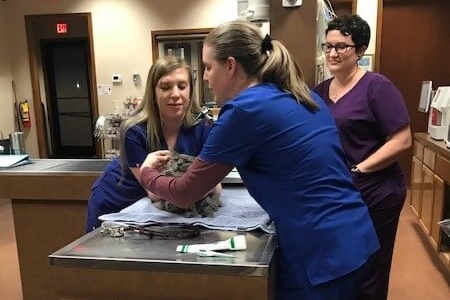The Next Generation

When you were young, what did you want to be when you grew up?
Me, I wanted to be a Greek mythology teacher. True story! At the age of 8, I knew I was fascinated by Greek mythology and my mom was in school to become a teacher, so it just made sense. Like many people, I grew up and decided on another occupation… or 2 or 3…
Dr. Haley, on the other hand, knew when she was a girl, all of 4 years old, that she wanted to be a veterinarian. She never lost sight of that dream. She started working to accomplish her goal at the age of 14 when she became a kennel technician. With hard work and dedication, she stayed true to her course, and today she owns her own practice. She is also passionate about giving others like her an opportunity to accomplish their goals.
While Greek mythology was not my ultimate academic pursuit, education was. Special education and cross-cultural communication, to be specific. As it turns out, I too am passionate about helping others accomplish their goals. So when we were approached by a local Veterinary Science 4H group to do a tour of the facility and answer some questions, we said, "Absolutely!" We've done these types of tours before for different age groups and for students from different backgrounds. It's always so exciting for us to see young people interested in what we do. And we love it when the students are able to really understand that we do more than cuddle puppies and kittens all day. (Side note: that only comprises part of our day, but it's a really important part!!)
We got to explain that while we all have a strong desire to help animals, by doing that, we also get to help humans. Did you know that, according to the CDC, only 23 cases of rabies were reported in the US between 2008-2017, and 8 of those people contracted the virus in other countries? That means only 15 humans contracted rabies in the US in about a decade. Other countries aren't faring so well. 90% of humans that have the rabies virus contract it from unvaccinated dogs. We got to tell them about parasites and diseases that can be transmitted from animal to human and how it's our responsibility to help keep everyone healthy. We talk about the importance of learning math and science and how cool it is to look at things under a microscope. (It really is cool!!)
When Dr. Haley and her staff of 6 were still in "the old building," that quaint mid-century, not-so-modern, 2 bedroom house we used to be in, she and her husband, Thomas, had a vision for something more. By the time I started in June of 2014, the foundation was laid and the beams were up on "the new building." I got to see it in its infancy and watch it grow into a place that would allow more pets to be healed. It would also allow for more people to have opportunities they wouldn't have had otherwise. It was never about having a "fancy new building."
Dr. Haley's intention was, from the beginning, to give back to the community. She wanted a place for college interns and externs to come and learn, hands-on, what it really means to be a doctor. She wanted to be able to teach anyone who wanted to learn, how to be a veterinary technician. We have student volunteers trying to get into school to be a veterinarian that needs so many hours in a real hospital as a prerequisite. We have young elementary and middle school students who come as a vet-for-a-day and find out if they really do want to be a veterinarian when they grow up. And we have tours. We have groups of students who are currently in 4H programs that are studying to be Certified Veterinary Assistants who come to see our hospital. This particular program is affiliated with Texas A&M which has one of the best veterinary programs in the United States. It gets them on the fast track to becoming a veterinarian if that's really what they want to do.
- How many children do you have in the 4H program and what are their ages? -We have two different 4H Vet Science programs running under the Williamson County 4H chapter. Our group has 10 students ranging from 12 - 18. The 4H Veterinary Science Certificate Program typically takes 3-5 years to complete the college-level apprenticeship in order to qualify for the CVA exam/certificate.
- How many total students are in your Vet Science group? -In both groups, there are a total of about 22 students.
- Did most of your group enjoy the tour? -Everyone loved the tour and the opportunity to see "behind the scenes" of the daily work (how medicines were given, how the different machines test for different things, and what things are looked for under the microscope.)
- Did you talk about it afterward as a group? - We meet formally once a month for tours or coursework reviews, so we haven't had our next meeting yet to discuss, but after our tour, I know the buzz was great! Everyone left excited and ready to come work with y'all!
- What were the students' favorite parts and least favorite parts of the tour?- I think everyone fell in love with Comet the Office Cat

